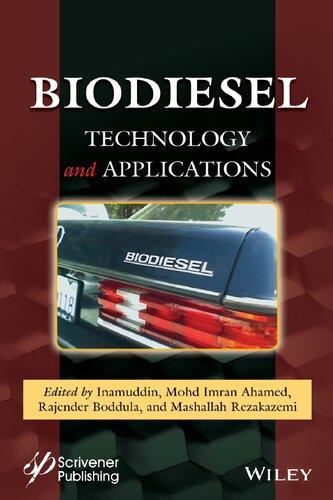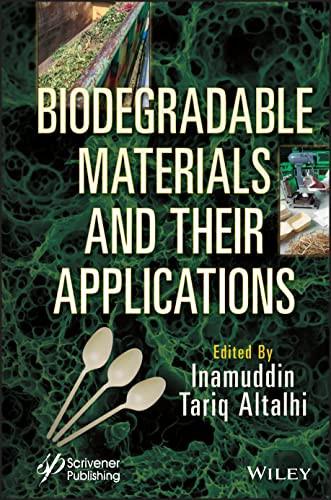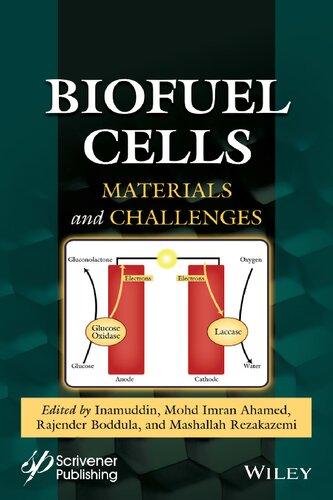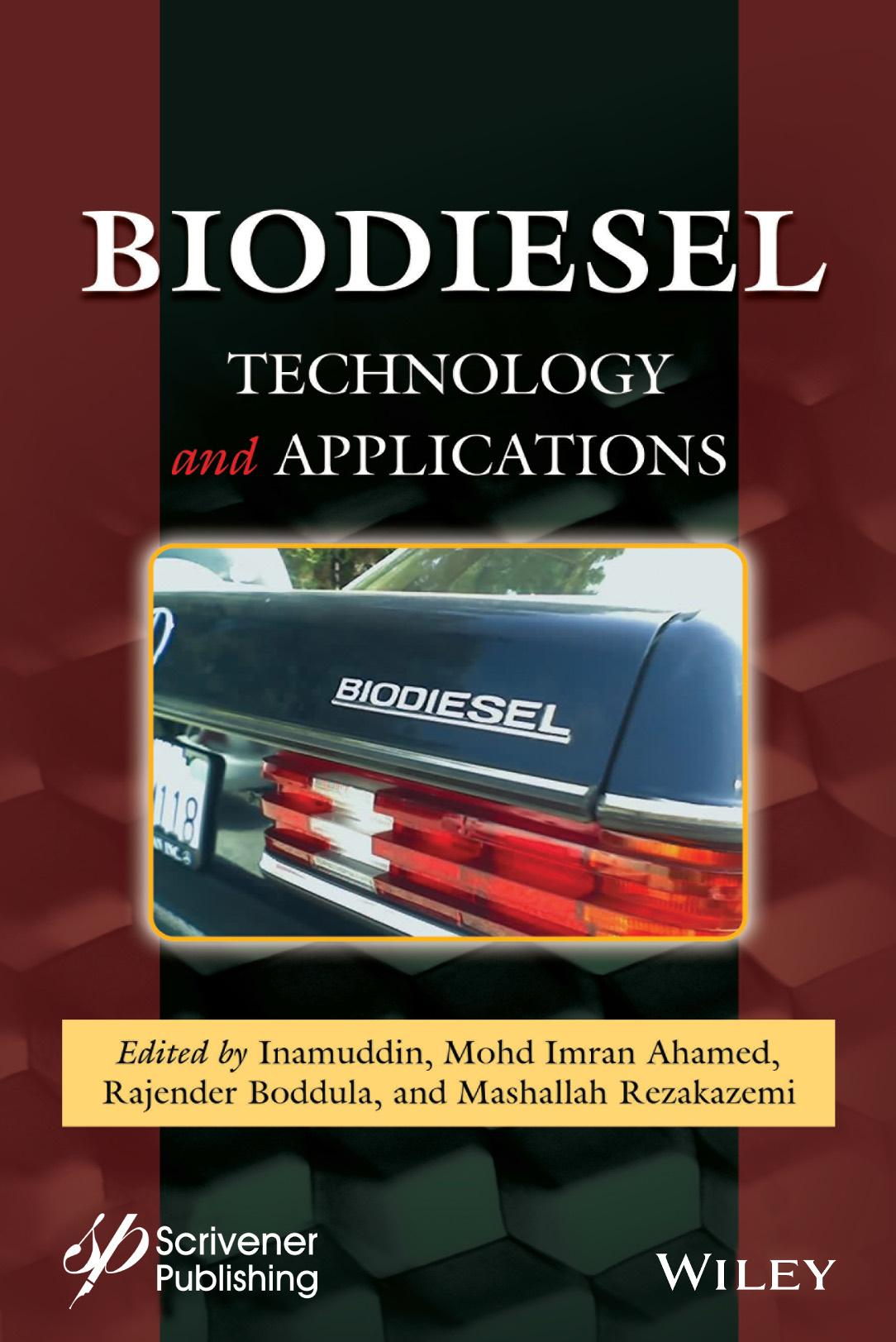Biodiesel Technology and Applications
Edited by Inamuddin, Mohd Imran Ahamed,
Rajender Boddula and Mashallah Rezakazemi
This edition first published 2021 by John Wiley & Sons, Inc., 111 River Street, Hoboken, NJ 07030, USA and Scrivener Publishing LLC, 100 Cummings Center, Suite 541J, Beverly, MA 01915, USA © 2021 Scrivener Publishing LLC
For more information about Scrivener publications please visit www.scrivenerpublishing.com.
All rights reserved. No part of this publication may be reproduced, stored in a retrieval system, or transmitted, in any form or by any means, electronic, mechanical, photocopying, recording, or otherwise, except as permitted by law. Advice on how to obtain permission to reuse material from this title is available at http://www.wiley.com/go/permissions.
Wiley Global Headquarters
111 River Street, Hoboken, NJ 07030, USA
For details of our global editorial offices, customer services, and more information about Wiley products visit us at www.wiley.com.
Limit of Liability/Disclaimer of Warranty
While the publisher and authors have used their best efforts in preparing this work, they make no representations or warranties with respect to the accuracy or completeness of the contents of this work and specifically disclaim all warranties, including without limitation any implied warranties of merchantability or fitness for a particular purpose. No warranty may be created or extended by sales representatives, written sales materials, or promotional statements for this work. The fact that an organization, website, or product is referred to in this work as a citation and/or potential source of further information does not mean that the publisher and authors endorse the information or services the organization, website, or product may provide or recommendations it may make. This work is sold with the understanding that the publisher is not engaged in rendering professional services. The advice and strategies contained herein may not be suitable for your situation. You should consult with a specialist where appropriate. Neither the publisher nor authors shall be liable for any loss of profit or any other commercial damages, including but not limited to special, incidental, consequential, or other damages. Further, readers should be aware that websites listed in this work may have changed or disappeared between when this work was written and when it is read.
Library of Congress Cataloging-in-Publication Data
ISBN 9781119724643
Cover image: Pixabay.com
Cover design by Russell Richardson
Set in size of 11pt and Minion Pro by Manila Typesetting Company, Makati, Philippines
Printed in the USA
10 9 8 7 6 5 4 3 2 1
2 Application
Mohd Razealy Anuar,
Nor Irwin Basir and Ahmad Zuhairi Abdullah
2.8.1
4
5
3.4
Manjoro T.T., Adeniyi A. and Mbaya R.K.K. 4.1
4.2.1
5.1
4.3.1
5.3.1
5.3.4
5.3.1.4
5.3.1.5
5.3.1.6
5.3.1.7
5.3.1.8
5.3.1.9
5.3.3.2
5.3.3.3
5.3.3.4
5.3.4.1
5.3.4.2
5.3.5
5.5.1
5.5.2
5.5.3
5.5.2.1
5.5.2.2
5.5.3.1
5.5.3.2
5.5.4
5.5.5
5.6
6
6.5
6.6
8.5
8.3.4
8.3.4.1
12
V. C. Akubude, K.F. Jaiyeoba, T.F Oyewusi, E.C. Abbah, J.A. Oyedokun and V.C. Okafor
Azira Abdul Razak, Mohamad Azuwa Mohamed and Darfizzi Derawi
15.3
16.1
17.3.1
Muhammad Hilman Mustapha, Akhsan Kamil Azizi, Wan Nur Aini Wan Mokhtar and Mohamad Azuwa Mohamed
Preface
Energy technologies have attracted great attention due to the fast development of sustainable energy. Biodiesel technologies have been identified as the sustainable route through which overdependence on fossil fuels can be reduced. Biodiesel has played a key role in handling the growing challenge of a global climate change policy. Biodiesel is defined as the monoalkyl esters of vegetable oils or animal fats. Biodiesel is a cost-effective, renewable, and sustainable fuel that can be made from vegetable oils and animal fats. Compared to petroleum-based diesel, biodiesel would offer a non-toxicity, biodegradability, improved air quality and positive impact on the environment, energy security, safe-to-handle, store and transport, and so on. Biodiesels have been used as a replacement of petroleum diesel in transport vehicles, heavy-duty trucks, locomotives, heat oils, hydrogen production, electricity generators, agriculture, mining, construction, and forestry equipment.
This book describes a comprehensive overview, covering a broad range of topics on biodiesel technologies and allied applications. Chapters cover history, properties, resources, fabrication methods, parameters, formulations, reactors, catalysis, transformations, analysis, in situ spectroscopies, key issues and applications of biodiesel technology. It also includes biodiesel methods, extraction strategies, biowaste utilization, oleochemical resources, non-edible feedstocks, heterogeneous catalysts, patents, and case-studies. Progress, challenges, future directions, and state-of-the-art biodiesel commercial technologies are discussed in detail. This book is an invaluable resource guide for professionals, faculty, students, chemical engineers, biotechnologists, and environmentalists in these research and development areas. This book includes the eighteen chapters and the summaries are given as follows.
Chapter 1 details the biocatalytic production of biodiesel. Microbial enzymes such as lipases act as biocatalysts in the transesterification process of biodiesel production. Suitable and cost-effective feedstocks or
substrates for biodiesel production including their percentage yields are discussed. Factors that affect the enzymatic transesterification reaction are also explained.
Chapter 2 addresses ultrasonic energy which can increase the interface area while creating a thermal effect in heterogeneous biodiesel production process to result in higher biodiesel yield. Fundamental understanding of the improved reactant-catalyst interaction, the nature of the thermal effect, favorable process behaviors, reaction kinetic, as well as the effect on biodiesel quality is particularly addressed.
Chapter 3 is about the study of different types of catalysts used for biodiesel production. The classification of catalysts, advantages, and limitations, along with their mechanism, is explained. The heterogeneous catalysts’ synthetic methods and immobilization of biocatalyst are also discussed in detail.
Chapter 4 discusses various methods used to produce value-added chemicals from biodiesel-derived glycerol. The main focus being is given to hydrogenolysis as a transformative process to selectively produce 1,2propanediol and the advancements in biodiesel technologies. Furthermore, knowledge gaps are highlighted based on extensive literature research on the subject.
Chapter 5 discusses various techniques of synthesizing biodiesel and review of various existing analytical technologies for characterization of biodiesel. The chapter focuses on the current status of biodiesel in India, i.e., using non-edible sources and future feasibility of developing new methods of characterization to reduce the cost of biodiesel production.
Chapter 6 examines various established technologies available for the production of biodiesel, viz., chemical reaction, direct combustion, thermochemical conversion, and biomechanical conversion. Each technology is apportioned to a certain type of feedstock. Case studies, current status, and future potential of commercialization of biodiesel production in Africa are also discussed.
There is a huge demand for sustainable biofuel production in coming decades. The key challenges for biodiesel production are high FFA with the desired level of yield, stability, optimized and flexible production, commercialization of feedstock and environmentally friendly cycle. The collective effort and commitment of research survey regard feedstocks and commercialization of technology around the globe towards sustainable energy are expressed in terms of accelerating the biofuel economy in Chapter 7.
Chapter 8 provides an overview of the available feedstocks, production methods, and the benefits and constraints of using homogeneous, heterogeneous, and enzymatic catalysts for biodiesel. Some latest
intensification techniques to manage mass transfer restrictions of oil and alcohol phases along with some production cost reduction measures are also highlighted.
Chapter 9 discusses different types of feedstocks used for synthesizing biodiesel and feedstock selection criteria. Moreover, all biodiesel production methods (i.e., dilution with hydrocarbons blending, micro-emulsion, pyrolysis, and transesterification) are also described in detail with their advantages and disadvantages. The major focus is given to the various transesterification methods. Production methods also include experimental setup layouts, all process parameters, reaction conditions, the latest advancement in reaction processes, and their effects on biodiesel yield.
Chapter 10 reviews the potential use of non-edible feedstocks in the production of biodiesel. Special attention is given to the types of feedstocks available and their production pathways to biodiesel. The state-of-the-art technology, the properties of the fuel produced, and the environmental concerns of biofuels are also discussed.
Chapter 11 discusses the various types of oleochemicals and their usage. Optimization and production of biodiesel derived from oleochemicals and their properties are also discussed. The primary focus is given for the advantage of oleochemicals to be used as a potential feedstock for biodiesel production from the available literature.
Chapter 12 provides details about the different configurations of reactors used in biodiesel production. There are two types, namely, batch and continuous reactors. Recently, other improved configurations like microreactors have emerged. This chapter also discusses the merits and demerits of these reactors.
Chapter 13 highlights and discusses the international patents on biodiesel applications. This chapter reviews the recent patents on the generation of biodiesel which depends on the feedstock used, catalysts development, the latest method for biodiesel production, and reactor technology for the biodiesel production.
Chapter 14 overviews different reactions between a carboxylic acid (fatty acids) and alcohol (methanol and ethanol) over heterogeneous catalysts, an important step in biodiesel production. The nature of solid materials, like zeolites, heteropolyacids, materials with sulfonic groups, inorganic mixed oxides, and clays towards biodiesel production is discussed.
Chapter 15 sheds light on inedible feedstock that could be utilized for biodiesel production. Plant-based and non-plant feedstock are discussed. The waste lipid sources which are unfit for consumption are also highlighted. The chemical composition, economic viability, and sustainability of some of these feedstocks are equally explored.
Chapter 16 provides detailed information on the fabrication of biodiesel from microalgae. Specific information on the physical properties, amount of biodiesel production, and level of transesterification of biodiesel are discussed. The application of photobioreactors for the production of biodiesel with the special consideration of several factors such as flow rate, temperature, light intensity, CO2 concentration, and time is highlighted. Several techniques for the extraction of biodiesel such as supercritical CO2, physicochemical, direct transesterification, chemical solvents, and biochemical respectively are highlighted.
Chapter 17 discusses the biofuel classification in terms of origin and technological conversion of raw materials. Techniques capable of producing biodiesel on commercial scales are also presented. Furthermore, influential parameters and their roles in biodiesel production are elaborately covered. Finally, challenges and limitations confronting biodiesel uptake are presented.
Chapter 18 mainly explicates the application of nanoparticle catalysis for the high production of biodiesel. In particular, various types of catalyst nanoparticles with different synthesis strategy and their roles in enhancing the biodiesel production are discussed.
Inamuddin, Mohd Imran Ahamed, Rajender Boddula and Mashallah Rezakazemi
1 Biocatalytic Processes for Biodiesel Production
Ubaid Mehmood1, Faizan Muneer2, Muhammad Riaz3, Saba Sarfraz4 and Habibullah Nadeem2*
1College of Chemistry, Chemical Engineering and Biotechnology, Donghua University, China
2Department of Bioinformatics and Biotechnology, Government College University Faisalabad, Pakistan
3Department of Food Sciences, University College of Agriculture, Bahauddin Zakariya University, Multan, Pakistan
4Department of Chemistry, Government College Women University Faisalabad, Faisalabad, Pakistan
Abstract
Enzymes such as microbial lipases can be effectively used as biocatalysts for biodiesel production in a sustainable manner. Biocatalytic processes to produce biodiesel or biofuel is the need of time to reduce the emission of greenhouse gases produced from conventional diesel or fossil fuels. Lipases with excellent biochemical and physiological properties are most commonly used to catalyze the transesterification process for biodiesel production. Lipases obtained from microbes such as bacteria and fungi produce 70%–95% ethanol and methanol. Biodiesel is usually composed of fatty acid alkyl esters which are mono-alkyl esters of either fatty acid methyl esters or fatty acid ethyl esters depending upon the alcohol (acyl acceptor) being used in the reaction. Factors such as bioreactor type, acyl acceptor, temperature, and glycerol can affect the enzymatic transesterification reaction. Recombinant enzymes such as recombinant lipases can be employed to obtain higher percentage of biodiesel due to their high specificity and biocatalytic activity for different substrates used for biodiesel production.
Keywords: Lipases, biodiesel, biocatalysis, biofuels, Novozyme, free fatty acids, ethyl acceptors
*Corresponding author: habibullah@gcuf.edu.pk
Inamuddin, Mohd Imran Ahamed, Rajender Boddula, and Mashallah Rezakazemi (eds.) Biodiesel Technology and Applications, (1–58) © 2021 Scrivener Publishing LLC
1.1 Introduction and Background
Biofuels are crucial for the conservation of our natural environment and the climate. Biofuel such as bioethanol can be used for energy generation purposes which are currently being produced by fossil fuels such as petrol, diesel, and kerosene oil [1]. Being non-renewable energy sources, fossil fuels will not only deplete from the planet earth but will also leave a long-term impact on the globe both in terms of economy and climate change. Apart from being limited natural fuel reserves, there are countless reasons available that justify the need of natural and eco-friendly energy sources such as biofuels. Transportation, power generation, and house hold appliances use fuels directly or indirectly and for that purpose we are almost dependent on fossil fuels [2]. If efficient and robust methods and technologies are not worked out, we might come to a permanent stand still condition in the future when all our natural fossil fuel reserves will be vanished. The use of fossil fuel produces gases such as carbon dioxide (CO2), carbon monoxide (CO), sulfur oxides (SOx), and nitrogen oxides (NOx) which are unhealthy for human beings causing health issues such as asthma, skin diseases, and even cancers [3]. These by-products of fuel consumption affect not only human but also animals and plants on a broader view. Plant production and growth rates are highly effected by the changing environmental and climatic conditions due to heavy use of fossil fuels and their derivatives such as plastics [4].
Vehicular CO2 emission in the past decade was 20%, and it is estimated that by 2030, it will reach up to 80%. Liquide biofuels got prominence with the automobile industry. Peanut oil was used to make biofuel, i.e., biodiesel by Rudolph Diesel in 1898. Henri Ford who was the founder of Ford Company an automobile industry was also convinced by the idea of using biofuels in his automobile. During World War-II, Germany used biomass-based fuels for their machines which is the evidence of its use back in 1940s. The utilization of biofuels was presented, but after two major oil crises, first was in 1973 and second in 1978, and brought back its importance to public again. Biofuels that are produced using a large number of biomass sources are a sustainable solution for the environment and biosphere conservation. Being renewable energy resources and eco-friendly to the environment and life on earth, these are highly desirable products produced from renewable biomass substrates [5].
Currently, biofuels from various agricultural sources such as soybean oil, rapeseed oil, recycled waste oils, and waste plant residues are being studied. Depending on the feedstock type, processing technology and their developmental level, biofuels can be classified into first-, second-, and thirdgeneration biofuels. Biofuels produced directly from edible feedstock such
as crops, sugars, and edible oil using conventional techniques are considered as first-generation biofuels [6]. Non-edible feedstock such as waste crop residues like lignocelluloses and waste vegetable oils are required to produce second-generation biofuels which are comparatively economical and more sustainable as there is no food versus fuel competition. Highly advanced methods are used to produce second-generation biofuels which has certainly less flaws and ultimately improved to get greater yield [7]. We are currently in the phase of second-generation biofuels. Most of the processing techniques for second-generation biofuel production are not available at commercial level. One must think that the land dedicated for edible feedstock/crops will be compromised if we start cultivating non-edible crops in that land. Marginal lands can be used for the cultivation of grasses and other plants that are not a food for human or nor a fodder for animals on a larger scale. These plants or marginal grasses can be used for the production of second-generation biofuels. There have been a lot of research investigations to produce biodiesel using non-edible plant oils such as keranja oil, Jatropha curcas oil, tobacco oil, Calophyllum inophyllum oil, and castor oil [8]. Jatropha is an effective source of biodiesel production because of 30%–50% oil contents in its seeds [9]. The actual precursors of most of the second-generation biodiesel production are waste oils either in the form of waste cooking or industrial oils or animal fats. The utilization of these waste materials as feed stock helps in managing and disposing of waste material, which is one of the biggest problem for earth, for the benefit of environment [10]. In order to comprehend different biofuels, we can categorize them into four types which include biodiesel, bioalcohol (biomethanol, bioethanol, biobutanol), biogas, and biohydrogen. The most widely used biofuels are liquid biofuels such as biodiesel and bioethanol. Biofuels can be blended with other petro-based fuels in order to manage and enhance quality and quantity of fuel. Biofuel production includes chemical, thermal, and enzymatic methods. Among all methods, the most effective way to produce biofuels is through enzymes or biocatalysts [11]. Enzymes are becoming the focus of research to produce biofuels because of their advantages over other biofuel production techniques [12]. In this chapter, we discuss biodiesel production using biocatalytic processes and methods where different microbial enzymes (obtained from microorganisms) are used.
1.2 Importance of Biodiesel Over Conventional Diesel Fuel
Chemically, biodiesel is composed of fatty acid alkyl esters (FAAEs) which are mono-alkyl esters of either fatty acid methyl esters (FAME) or fatty
acid ethyl esters (FAEE) depending upon the alcohol (acyl acceptor) being used in the reaction [10]. Rudolf Diesel, the inventor of diesel engine, first used biodiesel in 1900 but that was highly viscous so that engine could not run effectively for a longer time [13]. Biodiesel is very suitable alternative to diesel fuel because of its remarkable properties and advantages, i.e., biodiesel carries 4.5 times greater energy than fossil fuel [14] and similar in chemical structure and energy content to conventional diesel [15]. It reduces approximately 85% carcinogenic compounds emission that is why it is very less toxic than conventional diesel fuel, free of sulfur, free of polycyclic aromatic hydrocarbons and metals, biodegradable, high cetane number (CN), and flash point [16]. It has the potential to reduce pollutants and emission of greenhouse gases [17] and is 66% more efficient lubricating agent than petro-diesel, which enhances life and performance of engine [18]. Blending of biodiesel with petro-diesel fuel that can affect important properties of fuel such as flash point, CN, kinematic viscosity, and lubricity is enhanced. It also decreases exhaust emissions and heat of combustion [19]. The largest biodiesel producer is EU (European Union) and biodiesel accounts 80% of the overall transport fuel in EU [20–22]. Biodiesel produced from different resources will have different composition and properties, but it must fulfill the standards and requirements of international standards of American society for testing materials and EU standards for biodiesel. Biodiesel has lots of applications such as it can be used as a fuel for aviation purposes [20], for electricity production using generators [21, 22] and in diesel fueled marine engines, because of its nontoxic and biodegradable properties environmental impacts on engines can be reduced. Alcohol type, quality of substrate that is to be converted, catalyst used, temperature of the reaction, and alcohol-to-oil molar ratio determine the performance of biodiesel production [23–25].
1.3 Substrates for Biodiesel Production
Biodiesel feedstock accounts for 60%–80% of the total cost; therefore, appropriate feedstock is required for economically valuable production of biodiesel [26]. In order to obtain economically beneficial and sustainable biodiesel, feedstock must be easily available, cheap, and sustainable. Feedstock is selected on the basis of biodiesel production that must be compatible to chemical composition and properties of feedstock to be used, percentage per dry biomass, agricultural potential, yield per hectare, and geographical region of that feedstock [27]. For example, soybean oil, palm oil, coconut oil, and rapeseed oil are mainly used as feedstock in
US, tropical countries like Indonesia, coastal areas, and European countries, respectively. Cultivation and climate conditions of the feedstock production area are also considered for its selection [28]. Depending on the nature, there are two types of feedstock for biodiesel production. First is the lipid raw material and second includes alcohol feedstock. Lipid sources can be divided into three categories, i.e., oils derived from plant sources (edible and non-edible oils), waste oils (waste cooking oils, industrial wastewater, lard, yellow grease, and animal fats), and oils from oleaginous microorganisms such as bacteria, fungi, and microalgae [29]. Properties of biodiesel like cold filter plugging point and oxidation stability are determined from the feedstock used for production. Feedstock properties like moisture content, impurities, content, and composition of free fatty acids (FFAs) affect the performance of engine [27, 28]. Composition of fats and oils including monoglycerides, diglycerides, and triglycerides are used for biodiesel production. Utilization of edible plant oils as feedstock is an expensive way for biodiesel production that leads to imbalance in food market and industry. It is also associated with some environmental problems like disruption of vital soil resources and deforestation due to mass propagation [29]. In order to solve problems linked with edible plant oils, the best alternate is the production of second-generation biodiesel which is produced by using non-edible (inedible) feedstock which are more favorable than edible oils due to reduction in cost and waste pollution, lower aromatic, sulfur contents, and high calorific value [8]. Inedible oils involve inedible plant oils, industrial waste, cooking oils, animal fats, and microalgal oils. Inedible oil producing plants have certain remarkable features that make them favorable to use, for example, they can be managed to grow in arid and semi-arid conditions and they do not require fertilizers and moisture for growth [24].
Repeated use of fried vegetable oils at high temperature leads to the production of waste cooking oils. Moreover, chemical composition of waste cooking oil is totally dependent on the oil from which it is derived. Hydrogenation, oxidation, and polymerization are the main chemical reactions that lead to production of very toxic and detrimental compounds for consumption. Fatty acid content of these oils lies in the range of 0.5% to 15% which is very much higher than refined oil having fatty acid content less than 0.5%. The waste cooking oil is known as yellow grease if the fatty acid content is less than 15% and it is called low value brown grease if the fatty acid content is higher than 15% [28]. Animal waste products like lard, tallow, animal fat, poultry fat, fish oil, and pork fat are also very effective feedstock for biodiesel production [30, 31]. Animal-based biodiesel is a good lubricating agent and has high percentage of saturated fats which decreases sedimentation risk and low temperature fluidity.
Moreover, it increases oxidative stability and cold filter plugging point of biodiesel which are the characteristics of good quality biodiesel. Utilizing these waste materials is an effective solution to encounter waste disposal. Apart from all these mentioned advantages of non-edible or waste oils, there are also some shortcomings or disadvantages, for example, low oil yield, higher carbon residue, unsaturated fatty acid content, and low volatility [29]. In some cases, large plantation land for inedible oils is required compared to edible ones, e.g., Pongamia pinnata and Jatropha has 2–50 folds less oil yield per hectare than palm oil so that is why they require much area to meet the demand [31]. Because of the drawbacks associated with second-generation biodiesel, scientists are looking for more efficient methods for biodiesel production. Biodiesel production using oleaginous microorganisms like bacteria, algae, microalgae, and fungi are considered as the future of biodiesel production that can meet global biodiesel demand for transportation fuels and other energy consuming applications [32]. Microbial oils are better than other plant oils because of their short life cycle and rapid growth, less requirement of space, labor, and easier scaling [33–35]. Microalgae as a feedstock is very effective because of its enormous advantages like they have high oil yield, can grow in salty and waste waters, use of non-arable land, and growth in 24 hours so multiple harvesting in a year is possible. If we give land area for microalgal growth then according to an estimate, only 2% of the US cropping land is enough for meeting 1/3 demand of US transportation fuels and less than 5% land is required to completely replace all transportation fuels [36–38]. Moreover, dry algal biomass can accumulate more than 80% oil without water and they have a capacity to produce oil yield 250 times greater than soybean water free oil [35]. Some examples of microalgae used for biodiesel production are Botryococcus sp., Cylindrotheca sp., Schizochytrium sp., Chlorella sp., and Nitzschia sp.
1.4 Methods in Biodiesel Production
There can be many ways for biodiesel production but esterification and transesterification are the two most widely used methods. Esterification is the reaction of FFAs and alcohol to make FAAEs and water is released, while transesterification is the reaction of triglycerides or triacylglycerols (TAGs) with alcohol to make FAAE and glycerol is produced as by-product [9]. Transesterification is slower than esterification process because of its multiple steps or reactions. It is a three-step process to convert TAGs into FAAE. In the first step, TAG reacts with one molecule of alcohol to produce one
molecule of FAAE and diacylglycerol (DAG). In second step, DAG further reacts again with one molecule of alcohol to produce one molecule of FAAE and monoacylglycerol and in the last step monoacylglycerol is converted into one molecule of glycerol and FAAE after reacting with an alcohol molecule. In each of these three steps, FAAEs are produced and in total one molecule of TAG and three molecules of alcohol are consumed to produce three molecules of FAAE and one molecule of glycerol [6–10]. Transesterification is a reversible reaction, and in order to make the reaction go forward to produce more biodiesel, we have to supply alcohol in large excess so that the reaction equilibrium shifts toward the product [36, 37].
1.5 Types of Catalysts Involved in Biodiesel Production
Biodiesel production process is carried by either catalytic or non-catalytic methods. Non-catalytic methods include use of alcohols or supercritical fluids or ionic liquids in the reaction system to produce biodiesel but mostly catalytic methods have been used for last 2 or 3 decades because of their advantages over non-catalytic methods [38]. Catalytic methods can be categorized into chemical homogenous catalysts, solid heterogenous catalysts, and biocatalysts.
1.5.1 Chemical Homogenous Catalysts
Chemical homogenous catalysts include combination of base and acid catalysts. NaOH, KOH, and methoxides are the base catalysts while HCl and H2SO4 are the acid catalysts [39]. Acid catalysts are mostly used to overcome the problem of FFAs in the reaction system but the rate of trans esterification by acid catalyst is slower than alkaline or base catalysts [8]. Chemical catalytic processes either alkaline or acid catalysis both have several disadvantages. Alkaline catalysis provides high conversion of triacyl glycerol into the alkyl esters in a very short time but it has many drawbacks. Alkaline catalysis is very prone to FFA concentration (>2.5%) in the reaction system because high FFA concentration results in saponification reaction producing soaps and leads to loss in enzymatic activity and makes difficult to separate transesterification by-product, i.e., glycerol from biodiesel. Hence, biodiesel yield decreases. Moreover, it needs high energy requirement [40]. To counter FFA problem, acid catalysts are used, e.g., sulfuric acid but it also causes some technical problems regarding separation and purification of glycerol. Moreover, acid catalysis is a slow process
compared to alkaline process. Reactors, pipelines, and other equipment are badly affected by acid catalysts because of their corrosive nature that can increase the cost of biodiesel production [41].
1.5.2 Solid Heterogeneous Catalysts
Solid heterogeneous catalysts include acid heterogenous catalysts and base heterogenous catalysts. Solid acid heterogenous catalysts include heteropolyacid catalysts (HPAs), mineral salts, acids, and cationic exchange resins. Among these, titanium oxide, sulfonic ion exchange resin, tin oxide, sulfonated carbon-based catalysts, zirconium oxide, zeolites, and sulfonic modified mesostructured silica are the main acid heterogeneous catalysts. Solid base heterogeneous catalysts have been categorized as mixed metal oxides, supported alkaline earth metals, single metal oxides, and nanooxides. Among these, the most studied are magnesium oxide, calcium oxide, and strontium oxide [44, 45].
1.5.3 Biocatalysts
Biocatalysts include enzymes especially lipases which are very popular in biodiesel production [43]. Enzymatic biodiesel production method diminishes problems associated with alkali and acid catalyzed methods. Use of enzyme catalysts has several economic and environmental advantages over chemical biodiesel production processes. Advantages of enzyme catalysis include production of pure and high market value glycerol, minor, or no waste water generation that is why treatment of waste water is not required, mild reaction conditions are required, no soap formation because enzymes can esterify low quality feedstock having high concentration of FFA that is why this method is insensitive to feedstock concentration. Enzymatic biodiesel production is simple so energy consumption is very low, enzymes can be reused because of their easy separation from the reaction mixture, and overall chance of contamination is lower than other transesterification methods [13].
1.6 Factors Affecting Enzymatic Transesterification Reaction
There are a lot of factors effecting enzymatic transesterification reaction such as source of enzyme, its type, preparation method, applying technique, its dosage, activity, and life time. Apart from these enzymes related factors, there are also some other factors which affect transesterification
reaction, e.g., feedstock type and its quality, type of alcohol as acyl acceptor, reaction pH, presence or absence of solvent, type of solvent, reaction temperature, alcohol-to-oil molar ratio [46].
1.6.1 Effect of Water in Enzyme Catalyzed Transesterification
Presence of water is not only required for chemically catalyzed biodiesel production but also very much required for enzymatic biodiesel production. It helps in maintaining enzyme structural confirmation and stability so it directly affects activity of enzyme. Oil-water interface is required for enzyme-substrate complex to proceed and water helps to increase this interfacial area [44]. So, without water, transesterification is not possible and absence of water can lead to permanent or temporal changes in protein (enzyme) structure. If water content is minimal, then increase in water concentration moves the reaction equilibrium toward more hydrolysis. Thus, it enhances reaction rate by providing greater stability to enzyme [45]. Excess of water content also has some negative effects on the reaction as well as on enzyme. Excess water content can be accumulated in the reaction medium and within enzyme active site, that leads to decrease the reaction rate as well as its alkyl ester yield [46]. So, concentration of water should be optimally perfect in order to gain maximum benefit from it. Every enzyme has its specific water content requirement, i.e., optimal water requirement, at which that particular enzyme performs its best [47, 48]. Optimal water content not only provides great support, flexibility, and stability to the enzyme but also maximizes transesterification yield by diluting methanol that has an inhibitory effect on enzyme. Factors that determine optimal water content include feedstock and type of solvent used, enzyme, and its immobilization technique used [48]. Chaudhary et al. [49] studied the effect of water content in lipase catalyzed transesterification. At low water activity (aw = 0.33), synthetic activity of enzyme was increased and at high water activity (aw = 0.96) enzyme became more hydrolytically active. They tested various enzymes/lipases at different water activity to check transesterification rates. The lipase from Aspergillus niger was found more prominent to give maximum transesterification rate of 0.341 mmolmin−1 mg−1 at a w = 0.75. Measuring water content as weight percentage is a better choice and more convenient to use than water activity (aw), measured by Karl-Fischer method [50]. Maximum methyl ester yield was at water concentration of 10-15% while increasing water content from 0% to 40% to study the effect of water in conversion of salad oil into methyl ester. But after much increased water concentration, methyl ester yield became very low. So, for maximum transesterification yield, optimum water concentration is required.











